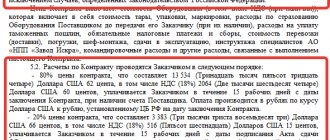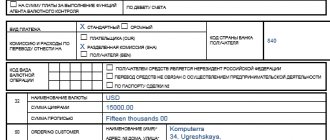According to the requirements of Art. Law No. 402-FZ dated December 6, 2011 “On Accounting”, all assets and liabilities of companies are reflected in accounting registers and reporting in the currency of the Russian Federation - rubles. This rule also applies to transactions carried out with the currencies of other states: the value of property, foreign currency money supply, investments or debts are converted into rubles. The criteria for generating information about property and liabilities, the value of which is expressed in foreign currency, are determined by PBU 3/2006. Since the beginning of 2021, a number of changes have been made to this document by order of the Ministry of Finance of the Russian Federation dated November 9, 2017 No. 180n. Let's find out more about them.
Accounting for foreign currency transactions in a new way
The main changes are also given in the Information message of the Ministry of Finance of the Russian Federation dated December 12, 2017 No. IS-accounting-10. The innovations affected the following operations:
On the use of cross rates
Clause 5 of PBU 3/2006 regulates the recalculation of any balance sheet position into rubles at the rate established by the Central Bank. Now, if a company needs to convert into rubles from a currency for which the official rate is not established by the Central Bank, this must be done using the cross rate calculated on the basis of exchange rates established by the Bank of Russia.
Example:
The company carried out a foreign currency transaction, receiving an advance of 100,000 Australian dollars (AUD) from an Australian partner. Let's say the Central Bank has not set the ruble exchange rate to this currency, but it is set to the US dollar (USD). Calculation (rate values are conditional):
- AUD/USD rate - 1.4029;
- RUB to USD exchange rate – 66.5022;
- RUB to AUD exchange rate – 66.5022 / 1.4029 = 47.4034;
- The advance received in terms of rubles is 4,740,340 rubles. (47.4034 x 100000).
By recalculating the share of accrued but unpaid revenue
According to the rules in force until the end of 2021 (clause 7 of PBU 3/2006), the cost is recalculated into rubles on the dates of the transaction and reporting (except for advances received and issued, prepayments, etc.). From 2021, revenue not presented for payment that exceeds the amount of the advance received will also be recalculated. In this case, the received prepayment (advance payment) is not recalculated.
Example:
In September, the company performed work under a contract worth 6,000 euros upon receipt of an advance in the same month in the amount of 50% (3,000 euros). The company prepares quarterly accounting reports. Let’s assume that the euro exchange rate set by the Central Bank was:
- on the date of receipt of the advance (September 10) – 70 rubles/euro;
- on the day of signing the certificate of completion (September 20) – 73 rubles/euro;
- on the reporting date (September 30) – 75 rubles/euro.
How an accountant will record transactions in foreign currency:
| In 2021 | |||
| Operation | D/t | K/t | Sum |
| As of 10.09. advance received (3000 x 70) | 51 | 62/Av | 210000 |
| As of 20.09. the act was signed, revenue of 429,000 rubles was recognized. (210000 + 3000 x 73) Advance credited | 62 62/Av | 91 62 | 429000 210000 |
| As of 30.09. (3000 x (75 – 73)) positive exchange rate difference for settlements with the buyer | 62 | 91 | 6000 |
| As of 30.09. (3000 x (75 – 73)) – other expenses from recalculation of the unpaid portion of revenue | 91 | 90 | 6000 |
For hedging currency risks
The new edition of PBU 3/2006 approved a mechanism for protecting assets from fluctuations in the foreign exchange market, for example, when a company conducts foreign trade activities. Currency risks can be hedged by executing transactions for the purchase and sale of foreign currency or agreements on deferred execution terms using various financial instruments, such as options, futures, forwards or swap agreements.
According to the new rules, from 2021, exchange rate differences on foreign currency assets acquired to protect against risks can be taken into account according to IFRS criteria (clause 14.1 of PBU 3/2006). This category of differences in exchange rates will not be subject to the provisions of clause 13 of PBU 3/2006 on accounting.
On doing business abroad
From the beginning of 2021, assets used by the company in its work abroad are subject to conversion into rubles, the value of which is recalculated today as of the date of acceptance for accounting (clause 17 of PBU 3/2006). These are mainly investments in fixed assets, intangible assets, goods and materials, etc. According to the new guidance, all such currency positions will have to be recalculated at the Central Bank exchange rate as of the reporting date (clause PBU 3/2006);
For enterprises conducting economically profitable activities, mainly in foreign currency (abroad or on the territory of the Russian Federation), clause 19.1 of PBU 3/2006 has clarified the accounting rules. Such a company will be able to separately generate in accounting and reporting forms information about foreign currency assets and liabilities for the corresponding segment, allocated in accordance with PBU 12/2010 “Information by Segments”.
Having listed the main upcoming changes, let us recall how accounting of transactions in foreign currency is carried out.
We apply PBU 3/2006 when receiving or issuing advances
When preparing financial statements in 2008, it is necessary to take into account the numerous changes that appeared in accounting this year. Among them is the new edition of PBU 3/2006. What should you pay attention to when applying the provisions of this accounting standard since 2008?
Changes to PBU 3/2006 “Accounting for assets and liabilities, the value of which is expressed in foreign currency”, which came into force in 2008, were made by Order of the Ministry of Finance of Russia dated December 25, 2007 No. 147n (hereinafter referred to as Order No. 147n). One of the key amendments to this accounting standard concerns the revaluation of the amounts of advances, prepayments and deposits received (issued) under contracts, the value of which is expressed in foreign currency (in conventional monetary units). Since 2008, a new order has been in effect:





